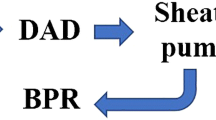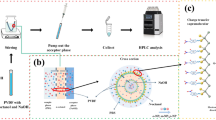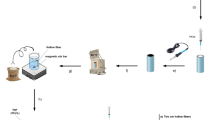Abstract
A simple and solvent-minimized sample preparation technique based on two-phase hollow fiber-protected liquid-phase microextraction has been developed and used for the determination of partition coefficient and analysis of selected pesticides in environmental water samples. The analysis was performed by gas chromatography–electron capture detector. Three pesticides namely hexaconazole, quinalphos, and methidathion were considered as target analytes. Extraction conditions such as solvent identity, salt concentration, stirring speed, extraction time, length of the hollow fiber, and volume of donor phase were optimized. The analytes were extracted from a donor phase (water sample) through 3 μL of an organic solvent immobilized in the pores of a porous polypropylene hollow fiber and then into the acceptor phase present inside the hollow fiber. Excellent extractions of the analytes were achieved under the optimized conditions, with relative standard deviations of 4.6–7.9%, correlation coefficients (r 2) of 0.9954–0.9986 and limits of detection of 3–7 ng L−1. The proposed method provided good average enrichment factors of up to 250-fold. The partition coefficients of the analytes determined were found to be directly correlated with the enrichment factor. The present methodology also confirms the robustness of microextraction for monitoring trace levels of pesticides in environmental water samples.







Similar content being viewed by others
References
Ho W-S, Pan H-J (2004) Anal Chim Acta 527:61–67
Lambropoulou DA, Albanis TA (2005) J Chromatogr A 1072:55–61
Chiang J-S, Huang S-D (2007) Talanta 71:882–886
Albanis TA, Lambropoulou DA (2004) J Chromatogr A 106:11–18
Esrafili A, Yamini Y, Shariati S (2007) Anal Chim Acta 604:127–133
Sanagi MM, See HH, Ibrahim WAW, Naim AA (2007) J Chromatogr A 1152:215–219
Gallardo E, Barraso M, Margalho C, Cruz A, Vieira DN, Lopez-Rivadulla M (2006) J Chromatogr B 832:162–168
Pan H-J, Ho W-H (2004) Anal Chim Acta 527:61–67
Albanis TA, Lambropoulou DA (2007) J Biochem Biophys Methods 70:195–228
Shariati S, Yamini Y, Darabi M, Amini M (2007) J Chromatogr B 855:228–235
Basheer C, Suresh V, Renu R, Lee HK (2004) J Chromatogr A 1033:213–220
Lee HSN, Lee HK, Basheer C (2006) J ChromatogrA. 1124:91–96
Psillakis E, Kalogerakis N (2003) Trends in Anal Chem 22:566–574
Lambropoulou DA, Albanis TA (2005) J Chromatogr A 1072:55–61
Acknowledgment
The authors are grateful to Universiti Teknologi Malaysia for the facilities, Ministry of Higher Education (MOHE) Malaysia for the financial support under vote 78084, and Ministry of Science, Technology and Innovation (MOSTI) Malaysia for National Science Fellowship to Nurul Auni Zainal Abidin.
Author information
Authors and Affiliations
Corresponding authors
Rights and permissions
About this article
Cite this article
Sanagi, M.M., Zainal Abidin, N.A., Wan Ibrahim, W.A. et al. Application of Double-Phase Liquid Phase Microextraction in the Determination of Partition Coefficients and Analysis of Pesticides in Water Samples. Chroma 71, 461–467 (2010). https://doi.org/10.1365/s10337-010-1475-3
Received:
Revised:
Accepted:
Published:
Issue Date:
DOI: https://doi.org/10.1365/s10337-010-1475-3




